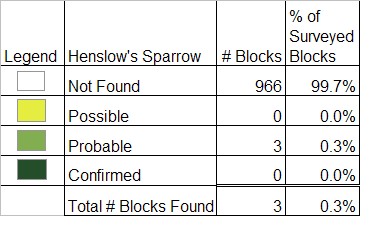Breeding Bird Atlases (BBA)
Find a Bird - BBA1
Breeding Bird Atlas 1 Species Accounts
Henslow's Sparrow
Ammodramus henslowii
State Status
Endangered
Egg Dates
May 20 to August 11
Number of Broods
two or perhaps three

The Henslow’s Sparrow in Massachusetts is a rare to very rare, erratic, and local breeder at the eastern edge of its historic range. Though described by Forbush in 1929 as a “rare to common local resident,” a steady decline began as early as 1935 and a major recession set in about 1950. The Henslow’s Sparrow is now a protected bird in Massachusetts and is listed as endangered by the Massachusetts Natural Heritage and Endangered Species Program. It is also a candidate for listing under the federal Endangered Species Act because its numbers are reduced throughout its range.
There have been few breeding records in the state since 1970. Two pairs definitely bred at the Leicester Airport in 1973 and 1974, and at least four singing males probably bred in West Newbury from May 18 to August 10, 1974. In 1983, four males were singing in Windsor in August and early September. The once-a-decade pattern continued when in Lincoln, in 1994, a pair was discovered building a nest on July 24, with evidence of a hatch on August 11 and of nestling care until August 20. The Lincoln male sang periodically from June 28 through September 6.
Loss of habitat is probably a major cause for the decline of this secretive and easily overlooked sparrow. Many grassland habitats have been developed or have become too overgrown, and others are often mowed too early, pastured too intensively, or converted to crops, turf, Alfalfa, etc. Furthermore, since the species is said to best thrive in fields of more than 75 to 250 acres, fragmentation may impede successful nesting. There is data that suggests that the breeding density, even in large fields, has been reduced in recent years, but the relative importance of predation, competition, weather, fragmentation, and human disturbance is poorly understood.
Breeding does at times occur on smaller plots. For example, the 1994 Lincoln pair nested in an isolated hayfield of 17 acres, of which 5 acres remained uncut at the time of the observed nesting in late July.
Breeding habitats include a variety of grasslands with tall, dense grass and herbaceous vegetation. In the Northeast, the species uses hay fields, pastures, wet meadows, dry salt marsh areas, and old fields. The sparrow can also be found in damp fields heavily overgrown with tall grasses, sedges, and low shrubs. The Lincoln pair was observed in an active hay field (about five years since replanting) of tall Orchard-grass and Timothy with scattered areas of Alfalfa, vetch, and dock; by the time of nesting in late July, the hay had become dense with matted patches.
Historically, the Henslow’s Sparrow generally arrived about May 6 and left by late September and October (with three winter records). Spring records since 1965 are May 16, 1976, and April 30, 1983. It is a small “mouse bird,” hiding and running in the dense grass and flying infrequently and only for short distances. During some of the breeding season, however, the male will occasionally perch on a weed or a fence post, throw its head back, and sing—obsessively, compulsively, every six to ten seconds for minutes on end. The typical song is a quick, thin, raspy, cricketlike tsi-lik. In Lincoln in 1994, these repetitive, emphatic vocalizations were more than once clearly audible across the hay field for a surprising 270 yards, though this was unusual. At other times, the male would apparently be silent for weeks or he would vocalize as infrequently as only one tsi-lik in an hour, sometimes faintly indeed. In late June and early July, the vocalization was a four-syllable (but still abrupt and raspy) te-tse t-lic, repeated infrequently.
Henslow’s Sparrows defend territories (which can be less than one acre in size) for as long as two months and occasionally during the breeding season change their location. Nests are typically constructed of woven grasses on or near the ground and are sometimes domed. For example, a nest may be tucked among the stems at the base of a clump of dense Orchard-grass. The females take 5 to 6 days to construct the nest. The North American Nest Record Program has no nest records from Massachusetts. There are usually three to five eggs. In the central part of their range, the first clutches are normally completed by late May. Incubation lasts about 11 days, and the male may sing from a nearby perch during this time. The young stay in the nest 9 to 10 days. Females make most of the feeding trips (which can be inconspicuous) during the first 4 or 5 days of the nestling period and about 50 percent of the trips during the latter half. In one study, 17 young were produced from 46 eggs, for a prefledging mortality of 63 percent. Henslow’s Sparrows usually raise two broods of young per breeding season, and perhaps three. Second nests are initiated in July and August with some extending into September (with young still in the nest). They may remain on their breeding grounds as late as the end of October before they migrate to the southeastern United States for the winter.
Map Legend and Data Summary
Atlas 1 data collected from 1975-1979


Note: very rare, local, and erratic in moist, shrubby fields; declining
Steven Ells



